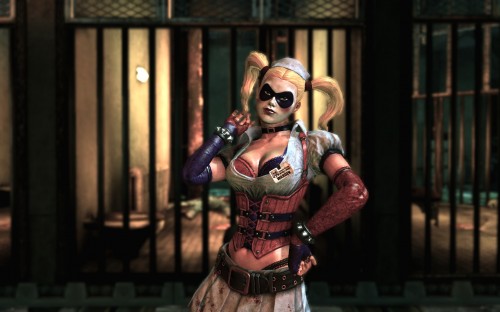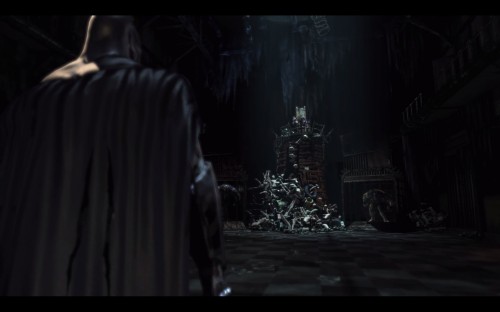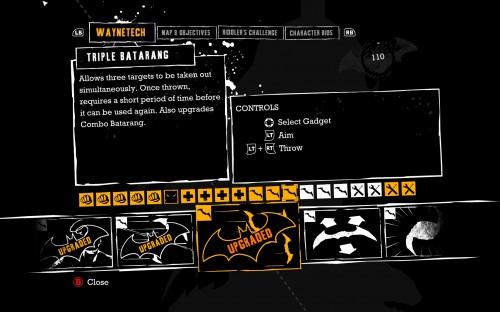Lately, there’s a tone in most of my postings. My tastes are moving away from story focused games into what I sometimes accidentally call “actual games”, even though every single game I’ve played is an “actual” game. Basically, I’m sort of being an ass about things, again. Recently, I started playing Batman: Arkham Asylum, and it’s getting a bit difficult to use the same brush I’ve been using lately. You know, the wide one.
What makes a good game?
When I write and talk about games like Dungeon Keeper or Might and Magic, I tend to emphasize how gamey they are; how they aren’t afraid to be games and that’s what makes them good to me. I like to say that a good atmosphere and a good story are great, but not necessary.
I’m still of that opinion. I think the biggest strength of a good game should be the actual game part. It’s a new media that uses elements of old media and then adds something of its own, so why not make that something the best part?
A good movie can be a good movie with crappy visuals, but at the end of the day, the visuals are a big part of why we go for the movie instead of a book. A crappy movie can have excellent visuals to, of course, but as crappy as the other parts are, with good visuals, it should be at least somewhat pleasing to watch. There’s still a good chance you’ll end up disappointed or displeased, though.
The thing is, you watch a movie and you read a book. The content is what it is and you consume it. Of course, everyone can interpret the content in their own way and each person’s experience can be as different as they get, but the common thing is that it’s still mostly a passive experience. Because of that, those other parts, not unique to that type of media, remain quite important, even with the new and unique part added on top of it all.
With a game, though, the unique part is active. You play the game. At least, in most games I like, it is that way.
A game can have a crappy, even non-existent story, visuals, music, anything, really, but as long as the game part is good, a lot of people will enjoy it. Some wont and that’s fine, but a lot of people will.
This is why I loved my experience with the Might and Magic series up to this point. This is why I played Ancient Domains of Mystery (ADOM) religiously while in high-school, even though there is no sound and the graphics consist of letters. These games contain mechanics to figure out and master, and challenges to overcome and that alone is good enough to keep me interested for a very long time.
Castlevania: Circle of the Moon, completely revolves around a story. It also has great music and atmosphere which both greatly improve on the basic experience. Even with those things, though, Circle of the Moon is a game that’s first and foremost a game. It has mechanics to master and challenges to overcome. Both of these aspects are excellently designed. They feel good to get through, fairly and appropriately challenging.
Dungeon Keeper might lack a bit on the fairness side, to the point where I’m certain there were plenty of people like me – people that loved the game but have never actually beaten it. Technically, even though I posted a “completed” article, I haven’t actually completely beaten the mod I was playing in either, only the objectives required by the original game. Even so, the mechanics of that game are fun just to mess around with.
Heck, Dwarf Fortress is a game you are meant to eventually fail at and will probably never truly master – it’s all about failing in the most interesting way possible.
There’s another extreme. Planescape Torment and the Walking Dead are both primarily revolving around stories.
I’m not doing another 180 degree turn here. I don’t consider the Walking Dead Season 1 an excellent game. It’s extremely far from game of the year material as many like to call it, in my opinion. Planescape Torment does a far better job at telling a story through a game than the Walking Dead.
In Planescape Torment, you play the story. The game part is the extremely enjoyable way through which the story unravels and opens up to you. In some way, you are in charge from the beginning, up to the end.
With the Walking Dead, the game part is a chore – the obstacle you have to get through (for some reason) in order to get to the next part of the story. It tries to be more than that, and it even manages to be symbolic in some ways and in certain moments, but for the most part, it’s just a bother. The story is good, but the game is not.
With Planescape Torment, I can’t wait to play another one of those, if there ever is one. With the Walking Dead, I’d just rather watch a silent Let’s Play.
What makes a game good?
See what I did there? I’m not sure I’m seeing it either.
I guess the better question would be, “What has this got to do with Batman: Arkham Asylum?”
Very little, probably.
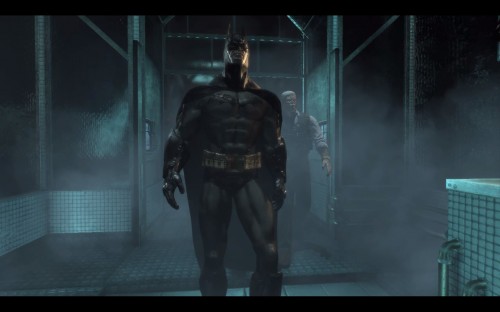
Pictured: I’m not an active follower of the graphic novels, so I have to ask, how does Gordon keep so fit?
The reason I wrote all that was because Arkham Asylum puts me in a weird place. In fact, it puts me all over the place.
The game part is formulaic
At times, I’m annoyed by the game part. Taking a step back from being immersed (I dislike that word), I’m noticing how formulaic Arkham Asylum can be at times. The entirety of the gameplay consists of several types of sections. I probably won’t list all of them, or I won’t take something into account, but I’ll try a poor and uneducated attempt at an analysis.
The elements of Batman: Arkham Asylum
Hard cutscene
At times, you completely lose control of Batman. There’s some part of the story that the game needs to show you, something some other character, a villain in most cases, does that you need to see. This is where the game ends and the story takes over. I don’t mind this, generally speaking. I just mind when it’s used as a crutch in cases where the designer couldn’t figure out how to do it through game play. In Arkham Asylum, these aren’t common and I’m not extremely bothered by them.
Soft cutscene
These are parts when you can still partially control, but the camera either shifts to give a better view of something nearby, or Batman moves at slow walking speed while talking to Oracle through his communicator.
In all honesty, I don’t really have a firm opinion on either hard or soft cutscenes in general or on how they work in Arkham Asylum. I just listed them for the sake of completeness.
They’re just OK.
Navigation
In these parts, your objective is to get from the entry point to the goal. The idea is that you need to figure out the way to navigate that part of the level. In fact, often when you enter an area, the camera will float towards the goal, just so you can better see where you need to go. It’s about using your grappling hook and other tools, figuring out where to jump, finding a proper air shaft, etc.

Pictured: A glitch in the Matrix. There are several moments where the game breaks the fourth wall. I won’t reveal the details.
There are side-objectives and obstacles here. You’re sometimes attacked by a lone enemy, or you need to get past part of the scenery (such as the poisonous plants later in the game), or you might find a Riddler trophy if you’re looking hard enough.
Gang fighting
These are different from the lone enemies that sometimes attack you during navigation parts.
You usually enter a room laid out like an arena, filled with a lot of enemies. Your objective is to properly use offense and defense to survive. If you do survive and knock down all the enemies, the experience you get will recover a big enough chunk of your health to eliminate the need for worrying about well you do. Staying alive at the end of it is well enough.
I don’t think there’s a way past most of these fights. You just have to beat them. There might be a way past some of the fights in the larges areas of Arkham, but you aren’t really encouraged to avoid fighting.
There are boss fights to and they are easy to figure out.
Stealth puzzle
Every now and then, you enter a room with armed enemies.
Your goal here is to defeat them stealthily, by using special take-down moves and staying out of sight. These stealth arenas are usually designed to facilitate this type of play. There are gargoyles along the walls to which you can attach and swing by, weak walls you can plant explosives on to disable passing enemies and various different cover spots where you can hide.
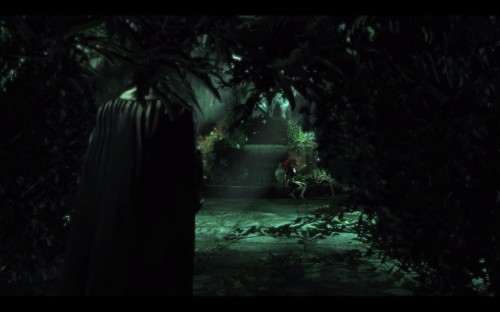
Pictured: I’ve always seen Posion Ivy as more naive and ideological than villain. This game doesn’t really change that view. She’s more tragic than evil.
Additional mechanics get introduced later in order to increase the challenge. For instance, some enemies wear alarm collars that are set off when they go unconscious, so the other patrolling enemies are alerted. Much later in the game, there are also explosives attached to the gargoyles, so you can’t use them as much.
Backtracking
This part is lightly more annoying.
Overall, Batman: Arkham Asylum is structured like a metroidvania.
In most metroidvania games, backtracking is rewarded by extra secrets to discover, random drops from enemies and more experience for your character.
Arkham Asylum uses the same approach, but it sometimes feels like the rewards aren’t substantial enough.
Special abilities are are acquired through gadgets Batman retrieves as part of the story. Outside of that, there is no other equipment, so your only rewards are extra experience from newly added joker teeth or enemies and any potential secrets you might find (Riddler trophies, riddles and interview tapes).
Basically, experience is your only reward and the upgrade system is not that complex, so even that isn’t extremely compelling.
Still, backtracking is short and quick for the most part, since the world isn’t that huge, so it doesn’t make the game worse in a significant way.
So why am I annoyed at times?
Because it isn’t perfect, I guess.
I know, that sounds like a REAL problem, but it is what it is.
Fighting is fun. It feels great and it looks cool. Sometimes, though, it drags on for a bit too long. Some other times, the animations don’t connect well, so it looks weird.
Navigating around is great, except it takes slightly too long to get that air went cover down and every now and then, the controls aren’t up to par and you mess up because Batman turned in the wrong direction, jumped when he was supposed to roll or maybe shot the grappling hook instead of crawling.
The stealth parts are OK, but make little sense and, I’m going to say it, feel too gamey. It sort of seems like the stealth parts are balanced at a too high level. On the one hand, it’s really easy to alarm the enemies and get too much attention. Enemies sometimes run across the entire room to an unconscious colleague. On the other hand, if you are spotted, you just have to jump across a bunch of gargoyles and suddenly they won’t see you anymore.
It feels like one part was taken up a notch to far, so to balance it out, the other one was taken up to the same level. It makes little sense on the side of realism and ends up playing a bit weird.
And the first two parts, the cutscenes, aren’t perfect either.
The voice-actors do a great job, but at times, the writing is not at the same level. There are moments where Oracle of Batman say some really weird things that seem very out of character. When the rest of story has a high production value, you tend to notice these things.
Also, the talks with Oracle, they tend to happen at very inconvenient times and when they do, all you can do is walk slowly, or just skip the cutscene so you can keep playing and maybe go collect that Riddler trophy you just spotted.
I’m not really sure, but I think I’m actually saying the story part gets in the way of the game part. You’d think I’d consider a good thing, because it means the game part is pretty good, but my opinion on this is that if you’re gonna work hard on making both the game and the story decent, you should also make them work together.
And I think that’s my biggest gripe with Batman: Arkham Asylum – I think the game and the story are at odds. Also, the story doesn’t really flow amazingly well and it develops a bit strangely at times, especially in the early parts of the second half.
Overall,…
… Batman: Arkham Asylum was a pretty good game.
And that’s the important part here. It’s a game. It’s structured as a game. It consists of a series of different types of challenges you are meant to overcome with a set of skills you are meant to master. The story can get a bit weird and not very good at times, but it flows that way because it serves to move the game forward, so you’d have clear objectives to complete.
It’s also a very formulaic game, but the formula is good, so it doesn’t take away too much from the overall quality.
I’ts a pretty good game.
Arkham Asylum gave me my required dosage of blockbuster and action, so I can now go back to the games I usually play.
For the price I got it for, it was worth it. For the initial price, I’d give it a pass, but that’s true for me and any other AAA game. Prices like that are still out of my comfort zone.
That being said, I’ve beaten it and I have no reason to go it ever again. I’ve also done it without completing most of the extra challenges, because I just didn’t feel like it.
For me, it was a game meant to be consumed and nothing more. Because of that, I can’t consider it an amazing game. It was a pretty good game, though.
Boy, all of these words just to give you a basic review.
Why am I full of it?
Because I enjoyed Batman: Arkham Asylum.
I enjoyed it, even though it does a lot of things in a way that I dislike and I actively wrote against recently.
Here I am, writing all of these 100% certain things about games and what I think about them, but then I go around not being true to my words.
I guess the reality is…
Look at that, I wanted to write down some truth I figured out again. This isn’t just me trying to have a writing style, I really caught myself trying to write down another truth i figured out.
I’m full of it because, in a few months, or even weeks, I’ll have it all figured out again, and again, and again… regardless of what I wrote here.

